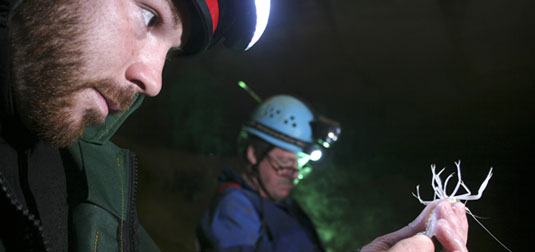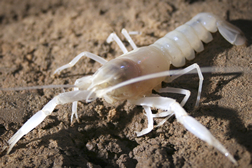


TUSCALOOSA, Ala. -- University of Alabama researchers are in the process of disproving a nearly 40-year-old theory about blind crayfish.
With the aid of an Alabama wildlife grant, members of the UA biology department are currently studying the life span of blind crayfish in Alabama caves.
A theory that originated in the early 1970s suggests cave organisms, specifically blind crayfish, can live for more than 100 years, said Bernie Kuhajda from the biology department.
Blind cave crayfish are different from surface crayfish in appearance and internal structure, Kuhajda said. They are a whitish color with long antennae. Also, because there is little to no light penetration in the caves, he said the crayfish do not have eyes.
Though the physical elements of the cave crayfish are different from the surface species, Alex Huryn, biology professor, said he questioned earlier theories.
"The life span of a surface crayfish is on average five to seven years. Five to seven, versus 100 is a big difference, and that's what we were trying to prove," Kuhajda said.
Mike Venarsky, a graduate student studying biology, said he associates this older theory with the fact that little is known about cave species, and much is assumed.
"There is this sort of dogma associated with cave species, that they are extremely long lived as compared with surface species," he said. "However, people don't have the data to back it up. With cave studies, people make a lot of assumptions and hypotheses, but they never test those hypotheses."
The research team of Kuhajda, Venarsky and Huryn used a catch and release process to test and monitor the cave crayfish.
By catching, measuring and marking them, Kuhajda said, the scientists can monitor the growth patterns and base their age off of that.
"If a blind crayfish grows to be six inches long, and it grows incrementally over from the times we catch it, then it makes sense that it could live to be 100 years old. But if that crayfish grows an inch a year, then six years is a good estimate of its lifespan," Kuhajda said.
After two years of research and approximately 1,200 marked crayfish, early results have shown cave crayfish may actually only live to be about 12 years old. This is twice as long as surface crayfish, yet not nearly as long as previous guesses.
The research was made possible when Kuhajda petitioned for an Alabama wildlife grant two years ago to further study blind crayfish. Studies began after the team received the grant.
Kuhajda said wildlife grants from the state are given as a preventative tool to study organisms that may become endangered and ecosystems that may become polluted.
"Caves are very susceptible to pollution," Kuhajda said. "In some caves, much of the life is gone already because of chemicals from the development above. The state was interested in these cave crayfish because caves across the country are experiencing this pollution pressure."
Through researching a blind crayfish's lifespan, the researchers said they want to find ways to save the cave crayfish population, as well as monitor their ecosystem.
"Most of the people that work with caves focus particularly on species distribution and finding new species. Very few people have focused on the actual ecology of the system, how pollution effects the system, and its water quality," Venarsky said.
Through the evolution and continuation of this research project, Venarsky
said he hopes to learn how the underwater ecosystems function. He said research
will continue for the next five years.
University of Alabama


